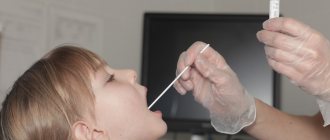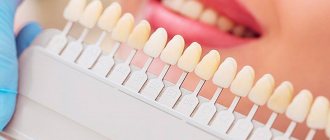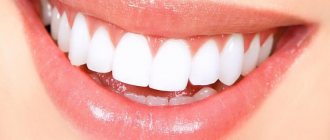With the birth of a child, parents try to control any changes in his behavior and well-being.
Therefore, even minor symptomatic manifestations in a baby can become a serious cause for concern .
A yellow coating on the tongue of a baby is a common phenomenon, indicating both diseases of the gastrointestinal tract or disturbances in the functioning of internal organs, and the need to replace a formula that is not suitable for the baby.
Note! In order not to worry about the baby’s health, it is worth taking a closer look at the causes of the symptom.
Why it appears: reasons
There may be several reasons why a yellow coating appears on the baby’s tongue :
- fungal infection of the oral cavity . Thrush or candidiasis, caused by a fungus of the genus Candida, contributes to the appearance of whitish or yellow deposits that resemble a dense curdled mass;
- autoimmune diseases. They arise as a result of the destruction of the body’s tissues by the body’s own immune system and cause the appearance of many unpleasant symptoms;
- pathologies of the digestive system . Diseases of the stomach and intestines become one of the main reasons for the formation of a yellowish coating on the surface of the baby’s tongue;
- liver diseases . Pathological processes in the bile ducts lead to disruption of the exchange of bile pigment bilirubin, which causes staining of the tongue and skin;
- diabetes. At the initial stage, endocrine-metabolic disease is characterized by the appearance of a yellowish coating, restless behavior and poor weight gain;
- congenital yellowness of the skin and tongue . This is due to the physiological characteristics of the child’s body. Over time, the problem disappears;
- infectious diseases of the ENT organs. A sharp increase in body temperature causes cracking of the tongue and bleeding from small capillaries, which provokes the appearance of plaque;
- low-quality formula for feeding a newborn. Often affects the formation of white or yellow plaque and accompanies the little patient until the parents switch the baby to another formula;
- penetration into the child’s body of toxic substances present in the environment. Toxic substances can also enter the digestive system through mother’s milk;
- parasitic diseases . Toxins produced by helminths or giardia have a negative effect on the child’s body, causing the appearance of a dense yellow plaque.
One of the possible and most common reasons for the formation of yellow deposits in infants is the transition from breastfeeding to artificial feeding .
Keep in mind! In this case, the symptom is temporary.
What does a yellow coating on a baby’s tongue mean?
In young children under one year of age, plaque often appears on the tongue and in the mouth. It’s okay if the plaque is white, it means candidiasis, but you shouldn’t be happy either, since a healthy child should have a clean oral cavity.
Candidiasis is a white coating that forms on a child’s tongue due to insufficient cleanliness of baby dishes, mother’s breasts, or pacifiers. To avoid it, mothers need to wash nipples before feeding, or sterilize baby bottles and pacifiers with boiling water.
The mistake of many young parents is that they mistake yellow plaque for white and continue to wash the child’s mouth with nystatin solution until other symptoms of the disease appear. If a child has such a plaque in his mouth, you need to urgently consult a doctor, preferably your pediatrician, in order to quickly become registered. Yellow plaque on the oral cavity of a baby is an extremely undesirable phenomenon. Plaque abundantly covers the oral cavity and is yellow in color when:
- There are problems associated with the digestive organs.
- Problems with the gallbladder, possibly dyskinesia. It is because of the increased secretion of bile that the plaque is colored yellow.
- Intoxication of the body.
- Disorders of the digestive organs.
- Stagnation of bile.
- The initial stage of jaundice.
- Advanced candidiasis.
This entire list is a mandatory reason to immediately visit a doctor. The doctor must identify the exact cause of the yellow plaque and prescribe appropriate treatment. If the cause of the plaque is jaundice , then he should issue a referral to the hospital. Hospitalization is also used in cases of acute intoxication of the body.
Features of consistency and thickness of plaque
The disease can be identified not only by the presence of yellow deposits on the surface of the tongue, but also by the thickness and consistency of such formations .
These features indicate the severity of the pathological process developing in the body of a small patient.
Reference! They also help determine the cause that influenced the occurrence of the symptom.
- A small layer of yellowish deposits that persists for several days warns of the presence of infectious diseases .
- Thick, loose formations indicate fungal infections or the presence of parasitic diseases.
- A thick layer of dry plaque indicates the development of autoimmune diseases.
- Dense and wet deposits present for three days. This indicates disturbances in the functioning of the gastrointestinal tract.
- A yellow patchy coating on the back of the tongue is a sign of liver or kidney problems.
Plaque due to gallbladder or liver disease
The cause of yellowness with a greenish tint in such cases is a significant increase in the concentration of bilirubin pigment
in the blood and bile due to the following diseases:
Plaque due to gastrointestinal diseases
- Stomach ulcer or gastritis
- symptoms of such diseases, along with an intense yellow coating, are heartburn, bitterness in the mouth, abdominal pain, nausea. - Inflammation of the pancreas and pancreatitis. My stomach also hurts and I feel nauseous.
- Various intestinal colitis
- also accompanied by diarrhea, pain in the lower abdomen and in the navel area, the appearance of blood or mucus in the stool. - Intestinal infections of various types
- salmonellosis, dysentery, food poisoning, staphylococcus. Usually accompanied by dehydration due to vomiting or diarrhea. The yellow coating becomes very dense and dry.
Plaque due to somatic pathologies
Yellow plaque may appear as a result of the following severe somatic diseases:
- Diabetes.
- Kidney diseases.
Associated symptoms
You should know! In addition to a yellow coating on the tongue, a newborn may notice many other symptoms indicating the presence of a certain disease.
Such manifestations are:
- bad breath;
- increase in body temperature to 37-39 degrees;
- yellowing of the skin and mucous membranes;
- change in color of urine and stool;
- increased salivation;
- tremor of the limbs;
- swelling of the tongue and gums;
- tearfulness , irritability;
- vomiting or frequent regurgitation ;
- the appearance of cracks and wounds in the corners of the mouth ;
- formation of hemorrhagic rash;
- redness of the oral mucosa;
- weight loss;
- diarrhea or constipation;
- restlessness when urinating;
- delay in psychomotor development.
Preventive measures
Measures to prevent the formation of yellowness on the tongue include the following recommendations:
- Daily oral hygiene will help avoid the appearance of unwanted plaque on the tongue; brush your teeth and oral cavity every day with a special scraper;
- Minimize consumption of products containing artificial or natural dyes;
- balance your diet by adding only healthy foods;
- minimize the consumption of carbonated drinks, black tea, coffee (although such drinks are generally not recommended for children);
- do not include smoked and fried dishes in the menu;
- do not overeat while eating;
- Regularly treat dishes and nipples for infants at high temperatures to kill bacteria.
When should you consult a doctor?
Important! Experts recommend not to delay visiting a pediatrician if you have one or more accompanying symptoms that cause discomfort to your baby and negatively affect his mood and general condition.
You should not put off going to the pediatrician in cases where :
- the plaque lasts for five days;
- it is not possible to remove deposits with a brush or bandage;
- the child refuses milk, is capricious and cries for no reason;
- formations appear on the gums and inside of the cheeks.
Carrying out diagnostics
You should know! After detecting signs of yellowness on the surface of the tongue, young parents should contact their pediatrician for an examination.
If during the initial examination the doctor reveals a pathology, in order to make an accurate diagnosis, he can additionally prescribe tests for the baby with the following diagnostic measures:
- taking a swab from the oral cavity for bacterial culture and determining the ratio of pathogenic and beneficial microorganisms;
- donation of urine and feces to determine the condition of the liver, gastrointestinal tract or pancreas;
- ultrasound examination of the digestive organs to check their condition, the presence or absence of inflammatory processes and neoplasms;
- biochemical blood test to assess the functioning of internal organs and the general condition of the body.
Stay up to date! One consultation with a pediatrician when yellow plaque appears in a child is not enough.
To make a diagnosis you may need to visit a specialist such as a gastroenterologist, infectious disease specialist, otolaryngologist, dentist, dermatologist, or toxicologist.
Treatment
Methods for eliminating yellow plaque depend on the cause of its occurrence .
If deposits appear after breastfeeding or formula feeding, you can remove the deposits using a small piece of sterile bandage soaked in a soda solution or plain water.
If the symptom was caused by various diseases, you will have to resort to drug treatment .
You should know! To eliminate plaque and treat the underlying disease, young patients are prescribed:
- hepatoprotectors that promote normal liver function;
- immunomodulators to restore the child’s immune system;
- anti-inflammatory drugs that eliminate pain, swelling and other symptomatic manifestations;
- antifungals for the treatment of oral candidiasis and thrush;
- enzyme preparations to restore intestinal microflora.
All medications should be used only as prescribed by a doctor..
Self-medication in this situation can lead to disastrous consequences.
Need to know! In order to prevent the reappearance of yellow plaque in the future or to prevent its formation, it is recommended to carry out simple but effective preventive measures:
- Regardless of the child’s age, establish proper nutrition . Do not give babies artificially colored foods or drinks.
- Promptly treat any infectious and non-infectious diseases.
- Regularly clean the child’s mouth from plaque and dirt using a special silicone fingertip.
- Nursing mothers should monitor their diet and follow a strict diet in the first months of the baby’s life.
- For newborns transferred to artificial feeding, select suitable formulas that do not cause allergies.
How to properly remove plaque from a child’s tongue
Thrush is a process of inflammation in the body caused by the fungus Candida.
There is a small safe amount of fungus in every body, but when the immune system decreases, the body ceases to control their formation and then the fungus multiplies and affects the mucous membranes.
Tongue staining from Fanta
There are simple and affordable means to combat thrush:
- After breastfeeding or formula feeding, give the baby a little water to drink each time, which will prevent candidiasis.
- Take a glass of warm boiled water and add one teaspoon of soda, then mix the solution. Then we wet a piece of gauze and gently wipe the baby’s tongue.
- Another effective remedy in the fight against thrush is honey. Mix honey and water at a ratio of 1:2 and wipe the mouth with this solution. But it is worth noting that honey is an allergen, and many babies vomit after eating sweets.
Decoctions for rinsing - chamomile and sage
For this reason, you need to carefully monitor the child’s reaction or use the product for older children.
There are also medications, but before using them, you should consult your pediatrician.
Cleaning a baby's tongue with a special soft brush
It is not recommended to let thrush take its course. As soon as you notice signs of thrush in your baby, treatment should begin. Otherwise, the child’s appetite and well-being may worsen due to the fact that it will be painful for him to eat.











